Functional differentiation of a clone resembling embryonic cortical interneuron progenitors
- PMID: 18814314
- PMCID: PMC2743477
- DOI: 10.1002/dneu.20679
Functional differentiation of a clone resembling embryonic cortical interneuron progenitors
Abstract
We have generated clones (L2.3 and RG3.6) of neural progenitors with radial glial properties from rat E14.5 cortex that differentiate into astrocytes, neurons, and oligodendrocytes. Here, we describe a different clone (L2.2) that gives rise exclusively to neurons, but not to glia. Neuronal differentiation of L2.2 cells was inhibited by bone morphogenic protein 2 (BMP2) and enhanced by Sonic Hedgehog (SHH) similar to cortical interneuron progenitors. Compared with L2.3, differentiating L2.2 cells expressed significantly higher levels of mRNAs for glutamate decarboxylases (GADs), DLX transcription factors, calretinin, calbindin, neuropeptide Y (NPY), and somatostatin. Increased levels of DLX-2, GADs, and calretinin proteins were confirmed upon differentiation. L2.2 cells differentiated into neurons that fired action potentials in vitro, and their electrophysiological differentiation was accelerated and more complete when cocultured with developing astroglial cells but not with conditioned medium from these cells. The combined results suggest that clone L2.2 resembles GABAergic interneuron progenitors in the developing forebrain.
(c) 2008 Wiley Periodicals, Inc.
Figures
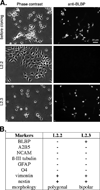

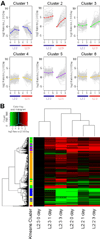
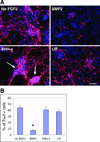
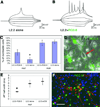
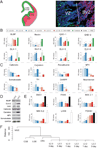

Similar articles
-
Isolation of a novel rat neural progenitor clone that expresses Dlx family transcription factors and gives rise to functional GABAergic neurons in culture.Dev Neurobiol. 2012 Jun;72(6):805-20. doi: 10.1002/dneu.20977. Dev Neurobiol. 2012. PMID: 21913335 Free PMC article.
-
Sonic hedgehog signaling confers ventral telencephalic progenitors with distinct cortical interneuron fates.Neuron. 2010 Feb 11;65(3):328-40. doi: 10.1016/j.neuron.2010.01.004. Neuron. 2010. PMID: 20159447 Free PMC article.
-
Physiologically distinct temporal cohorts of cortical interneurons arise from telencephalic Olig2-expressing precursors.J Neurosci. 2007 Jul 18;27(29):7786-98. doi: 10.1523/JNEUROSCI.1807-07.2007. J Neurosci. 2007. PMID: 17634372 Free PMC article.
-
Duration of culture and sonic hedgehog signaling differentially specify PV versus SST cortical interneuron fates from embryonic stem cells.Development. 2015 Apr 1;142(7):1267-78. doi: 10.1242/dev.111526. Development. 2015. PMID: 25804737 Free PMC article.
-
Cortical interneuron fate determination: diverse sources for distinct subtypes?Cereb Cortex. 2003 Jun;13(6):670-6. doi: 10.1093/cercor/13.6.670. Cereb Cortex. 2003. PMID: 12764043 Review.
Cited by
-
The early fetal development of human neocortical GABAergic interneurons.Cereb Cortex. 2015 Mar;25(3):631-45. doi: 10.1093/cercor/bht254. Epub 2013 Sep 18. Cereb Cortex. 2015. PMID: 24047602 Free PMC article.
-
An enhanced role and expanded developmental origins for gamma-aminobutyric acidergic interneurons in the human cerebral cortex.J Anat. 2015 Oct;227(4):384-93. doi: 10.1111/joa.12198. Epub 2014 May 20. J Anat. 2015. PMID: 24839870 Free PMC article. Review.
-
Cornu Ammonis Regions-Antecedents of Cortical Layers?Front Neuroanat. 2017 Sep 26;11:83. doi: 10.3389/fnana.2017.00083. eCollection 2017. Front Neuroanat. 2017. PMID: 29018334 Free PMC article. Review.
-
Isolation of a novel rat neural progenitor clone that expresses Dlx family transcription factors and gives rise to functional GABAergic neurons in culture.Dev Neurobiol. 2012 Jun;72(6):805-20. doi: 10.1002/dneu.20977. Dev Neurobiol. 2012. PMID: 21913335 Free PMC article.
-
Production and organization of neocortical interneurons.Front Cell Neurosci. 2013 Nov 21;7:221. doi: 10.3389/fncel.2013.00221. Front Cell Neurosci. 2013. PMID: 24312011 Free PMC article. Review.
References
-
- Anderson SA, Eisenstat DD, Shi L, Rubenstein JL. Interneuron migration from basal forebrain to neocortex: dependence on Dlx genes. Science. 1997;278:474–476. - PubMed
-
- Anderson SA, Marin O, Horn C, Jennings K, Rubenstein JL. Distinct cortical migrations from the medial and lateral ganglionic eminences. Development. 2001;128:353–363. - PubMed
-
- Anthony TE, Klein C, Fishell G, Heintz N. Radial glia serve as neuronal progenitors in all regions of the central nervous system. Neuron. 2004;41:881–890. - PubMed
-
- Bernard O, Reid HH, Bartlett PF. Role of the c-myc and the N-myc proto-oncogenes in the immortalization of neural precursors. J Neurosci Res. 1989;24:9–20. - PubMed
Publication types
MeSH terms
Substances
Grants and funding
LinkOut - more resources
Full Text Sources
Miscellaneous

